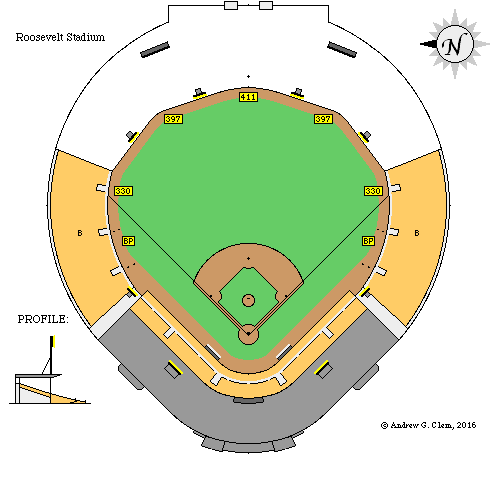Roosevelt Stadium was an Art Deco-style Public Works Administration project named for the Father of the New Deal, FDR. It was located in Jersey City, at Droyer's Point on the east shore of the Newark Bay, four miles straight west of lower Manhattan. Compared to other ballparks, it stood out in the way that the uncovered portions of the grandstand made a huge, broad arc around the corners of the field, putting some fans far from the action. (NOTE: A seating chart on one of the Web sites listed below indicates different dimensions: 377 feet and 401 feet to the short and deep power alleys, respectively; the shape of the outfield fence on that chart, however, is not consistent with those dimensions.) A major league game was played there for the first time nineteen years after it was built, as the Dodgers played here for seven games in 1956 and eight games in 1957. (See Anomalous stadiums.) It must have been hard for the Dodgers to leave behind their fine but aging home at Ebbets Field to play in this humble venue. The Dodgers' owner, Walter O'Malley, was pressuring city officials to help fund a new stadium, and ostentatiously held games across the Hudson River to see whether he could generate interest in the Garden State to build a new stadium there. The answer was "no," so in 1958 he loaded up his team and moved to L.A.
 Roosevelt Stadium was fairly unique, but its overall shape and the vast area enclosed by the brick perimeter wall beyond the outfield bear a distinct resemblance to another stadium built in the 1930s, Cleveland Stadium. It's hard to imagine that that is entirely coincidental. Another subtle design feature that was actually decades ahead of its time was the circular alignment of the outfield bleachers. There were plans to extend those bleachers toward center field, which would have nearly completed the circle on that side. (That explains why the perimeter wall was built in a circle.) So perhaps RFK Stadium was not the first cookie-cutter stadium after all!
Roosevelt Stadium was fairly unique, but its overall shape and the vast area enclosed by the brick perimeter wall beyond the outfield bear a distinct resemblance to another stadium built in the 1930s, Cleveland Stadium. It's hard to imagine that that is entirely coincidental. Another subtle design feature that was actually decades ahead of its time was the circular alignment of the outfield bleachers. There were plans to extend those bleachers toward center field, which would have nearly completed the circle on that side. (That explains why the perimeter wall was built in a circle.) So perhaps RFK Stadium was not the first cookie-cutter stadium after all!
Apparently the only memorable feat from the fifteen major league games that were played here was when Willie Mays hit a home run beyond the outer perimeter wall, the only player ever to do so. College football games and other public events were held here over the years, and sometimes the gridiron was laid out parallel to the first base line. Under the original plan, fans in the curved bleacher sections were far from the sidelines. (Both layouts are shown in the diagrams above.) During the 1960s and 1970s, there were several major rock concerts, including Pink Floyd, Eric Clapton, the Beach Boys, and the Eagles. Roosevelt Stadium gradually fell into decay, and demolition on it began in 1984. Confusion has arisen over this, since there were two Roosevelt Stadiums, the one in Jersey City represented on this page, and a much smaller one in Union City which is used for high school sports and was renovated in 1985. Minor league baseball games and football games are played there. In the land where this Roosevelt Stadium once stood, there is now a residential neighborhood.
SOURCES: Lowry (2006), jerseycityonline.com, njcu.edu, Library of Congress
FAN TIPS: Adam Myers, Bruce Orser


